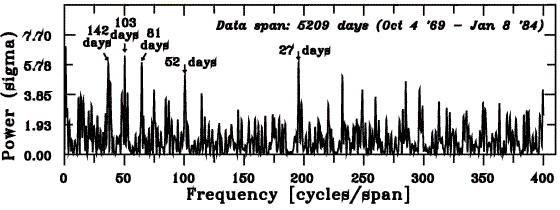
Proc. 27th Meeting Polish Astron. Soc.,
Poznań, September 12–15, 1995
(eds.: M.J. Sarna, P.B. Marks), 65 – 66.
| Toruń Radio Astronomy Observatory, Nicolaus Copernicus University, ul. Gagarina 11, PL-87-100 Toruń, Poland |
Single frequency solar radio patrol observations at 127 MHz have been carried out at the Toruń station since autumn of 1958. The collected measurements of the daily mean flux densities were recently corrected for various factors to form a uniform data base (Gawrońska et al. 1994).
The base (updated with the most recent results) have the following statistical parameters:
|
From our analysis it follows that (see Fig. 1):
 |
| Figure 1: Fourier power spectrum (standard deviation units) of the daily flux densities of the Sun at 127 MHz in the period Oct. 4, 1969 to January 8, 1984. |
| (1) | In the 22 cycle of sunspot activity, besides the slowly varying component (27 days), there exists a component at 24 days which has been discovered over 1988 to 1991 (thus it is not seen in Fig. 1). |
| (2) | 51.7-day period is present in the years 1958 – 1985 (in May of 1985 starts an almost 2-year gap in our data) and is especially pronounced in the years 1980 – 1982 and to a lesser extent in 1966 – 1968. This oscillation may correspond to the one found in the radio emission at 10 cm wavelength by Pap et al. (1990). |
| (3) | 80.6-day period is detected up to 1989 and is more pronounced just after the maxima of the sunspot cycles No 20 and 21, especially in the years 1970 – 1974 and 1980 – 1989. 78-day and 84-day periods were observed in the radio flux at 10 cm, in sunspot area and in flare activity (Bai and Sturrock 1991). |
| (4) | 103.3-day period is seen during the 20th and 21st sunspot cycle, and especially in the years 1969 – 1976. This agrees well with Bai and Sturrock's (1991) 103-day period that exists in the rate of large flares. |
| (5) | 142.3-day periodicity exists over the years 1973 to 1992 with clear enhancements in the years 1973 to 1976 and 1981 to 1983. |
REFERENCES
Bai T., 1992, Astrophysical Journal Letters, 388, L69 – L72.
Bai T., Sturrock P.A. 1991, Nature, 350, 141 – 142.
Gawrońska G., Borkowski K.M., 1995, in: Radio Emission from the
Stars and the Sun, eds. A.R. Taylor and J.M. Paredes,
(in print)
[Astron. Soc. Pacific Conf. Series, 93, 397 – 399].
Gawrońska G., Borkowski K.M., Usowicz J.B., 1994,
Acta Astronomica, 44, 141 – 164.
Pap J., Tobiska W.K., Bouwer S.D. 1990, Solar Physics, 129,
165 – 189.
Schove D.J. (ed.), 1983, Sunspot cycles, Hutchinson
Ross Publ. Co., Stroudsburg (Penn., USA), p. 378.